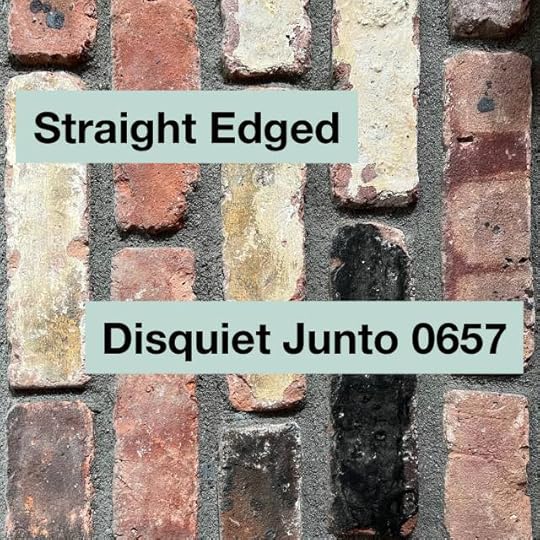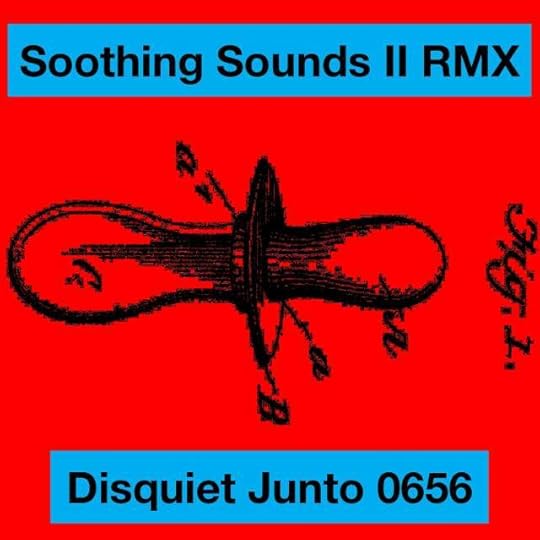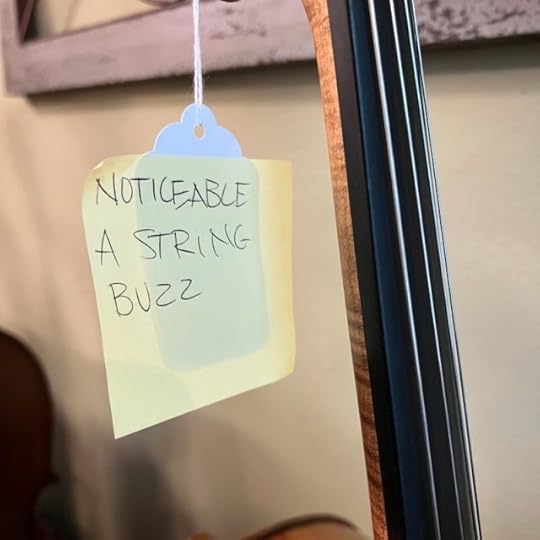Marc Weidenbaum's Blog, page 52
August 2, 2024
August 1, 2024
Disquiet Junto Project 0657: Straight Edged

Each Thursday in the Disquiet Junto music community, a new compositional challenge is set before the group’s members, who then have five days to record and upload a track in response to the project instructions.
Membership in the Junto is open: just join and participate. (A SoundCloud account is helpful but not required.) There’s no pressure to do every project. The Junto is weekly so that you know it’s there, every Thursday through Monday, when your time and interest align.
Tracks are added to the SoundCloud playlist for the duration of the project. Additional (non-SoundCloud) tracks also generally appear in the lllllll.co discussion thread.
Disquiet Junto Project 0657: Straight Edged
The Assignment: Held tones, sharp edges.
There is just one step this week:
Record a piece of music that consists of nothing but held tones of varying lengths that start and end suddenly and that overlap as the piece unfolds.
Tasks Upon Completion:
Label: Include “disquiet0657” (no spaces/quotes) in the name of your track.
Upload: Post your track to a public account (SoundCloud preferred but by no means required). It’s best to focus on one track, but if you post more than one, clarify which is the “main” rendition.
Share: Post your track and a description/explanation at https://llllllll.co/t/disquiet-junto-project-0657-straight-edged/
Discuss: Listen to and comment on the other tracks.
Additional Details:
Length: The length is up to you.
Deadline: Monday, August 5, 2024, 11:59pm (that is: just before midnight) wherever you are.
About: https://disquiet.com/junto/
Newsletter: https://juntoletter.disquiet.com/
License: It’s preferred (but not required) to set your track as downloadable and allowing for attributed remixing (i.e., an attribution Creative Commons license).
Please Include When Posting Your Track:
More on the 657th weekly Disquiet Junto project, Straight Edged — The Assignment: Held tones, sharp edges — at https://disquiet.com/0657/
July 31, 2024
Talking About Soundscapes
“If you’ve ever used the word ‘soundscape,’ you owe a small debt to the late Canadian composer R. Murray Schafer. You can repay that debt by simply taking the opportunity to listen—and doing so in an ‘openly attentive’ manner, as Schafer put it in his 1969 book, The New Soundscape.”
And that’s how my new essay at JSTOR Daily begins. It’s all about the origins of the modern usage of the word “soundscape,” and it follows up an earlier piece I wrote for JSTOR Daily, last year, about the sound design of the film American Graffiti.
I’ll have a bit more on the piece in the coming days.
July 30, 2024
My Robin Sloan Interview

I got to interview Robin Sloan for 48 Hills about his recent novel, Moonbound. I have an extra tidbit from the interview that I’ll share here later this week. Meanwhile, here’s one of my favorite parts of the interview:

Read the full piece at 48hills.org.
July 29, 2024
Little Red Box
It’s a Monday and you’re sitting in your office typing away, and there’s plenty to listen to, but why not whip up a quick little reworking of a loop from the FM3 Chan Fang Buddha Machine that someone recently sent to you as a gift? (Audio processed in VCV Rack. Buddha Machine audio inputted into a MacBook via an Edirol UA-25EX audio interface.) And a side note: SoundCloud shows this track as having been “mastered,” but that’s not the case. I did experiment with the built-in SoundCloud mastering option, applying the “Aurora” version, but it ended up too shrill for my ears. The ringing in particular sounded like a fire alarm was going off the whole time, so I replaced it with the original.
July 28, 2024
Early Evening

If it’s early Sunday evening and there’s ambient-inflected jazz being performed one room over and this is what the bathroom looks like then life is OK and you’re making good decisions
July 27, 2024
Scratch Pad: Haiku, 666, Cables
I do this manually at the end of each week: collating most of the recent little comments I’ve made on social media, which I think of as my public scratch pad. I also find knowing I will revisit my posts to be a positive and mellowing influence on my social media activity. I mostly hang out on Mastodon (at post.lurk.org/@disquiet), and I’m also trying out a few others. And I generally take weekends off social media.
▰ Which will come first: (A) the confirmation email from the editor to whom you sent the article you just finished writing, or (B) the surveillance-capitalist alert from Amazon to purchase random things you happened to research in the context of writing the article?
▰ The readymade haiku of Wikipedia’s notable deaths:
Hungarian short track speed skater
Italian robber
Maltese painter and sculptor
▰ This week’s Disquiet Junto project will be the 656th consecutive weekly project, which means that in 10 weeks we’ll hit 666.
▰ Do you have favorite email newsletters by electronic (and adjacent) musicians where they regularly include examples of their recordings? Mine are from Andrew Tasselmyer, Marcus Fischer, Chris P. Thompson, and Taylor Deupree. If you have others, I’d love to check them out. Thanks.
▰ Splitting my synth into a few cases made sense. But I’m gonna need some much longer cables.
▰ I read a ton this week, but only finished one book, the massive, 400-page first 12 issues of Howard Chaykin’s American Flagg!, which I haven’t read since the previous millennium. It holds up. Also good to have re-read it shortly after reading Chantal Montellier’s earlier Social Fiction.
July 26, 2024
July 25, 2024
Disquiet Junto Project 0656: Soothing Sounds II RMX
Each Thursday in the Disquiet Junto music community, a new compositional challenge is set before the group’s members, who then have five days to record and upload a track in response to the project instructions.
Membership in the Junto is open: just join and participate. (A SoundCloud account is helpful but not required.) There’s no pressure to do every project. The Junto is weekly so that you know it’s there, every Thursday through Monday, when your time and interest align.
Tracks are added to the SoundCloud playlist for the duration of the project. Additional (non-SoundCloud) tracks also generally appear in the lllllll.co discussion thread.

Disquiet Junto Project 0656: Soothing Sounds II RMX
The Assignment: Make music for babies’ parents.
Last week’s project involved making soothing sounds for babies. This week the plan is to transform those sounds into something for parents (where Creative Commons licenses or other agreements allow).
Step 1: Listen through and locate a track from project 0655 that (a) is something you’d like to rework and (b) is available for reworking. If it doesn’t have an evident Creative Commons license allowing for re-use, consider contacting the musician for permission. Or just find another track. You’ll find them at disquiet.com/0655 and in the llllllll.co thread.
Step 2: Take the piece of music from Step 1 that was intended as soothing sounds for babies and transform it into something intended as Soothing Sounds for Parents. (Yes, yes, parents might certainly enjoy the original material, but please push it beyond the bassinet.)
Tasks Upon Completion:
Label: Include “disquiet0656” (no spaces/quotes) in the name of your track.
Upload: Post your track to a public account (SoundCloud preferred but by no means required). It’s best to focus on one track, but if you post more than one, clarify which is the “main” rendition.
Share: Post your track and a description/explanation at https://llllllll.co/t/disquiet-junto-project-0656-soothing-sounds-ii-rmx/
Discuss: Listen to and comment on the other tracks.
Additional Details:
Length: The length is up to you.
Deadline: Monday, July 29, 2024, 11:59pm (that is: just before midnight) wherever you are.
About: https://disquiet.com/junto/
Newsletter: https://juntoletter.disquiet.com/
License: It’s preferred (but not required) to set your track as downloadable and allowing for attributed remixing (i.e., an attribution Creative Commons license).
Please Include When Posting Your Track:
More on the 656th weekly Disquiet Junto project, Soothing Sounds II RMX — The Assignment: Make music for babies’ parents — at https://disquiet.com/0656/
The image associated with this project is from an early patent for a pacifier.
July 24, 2024
‘Sunny,’ Episode 4: Sticky
Correct me if you see other examples, but there wasn’t anything particularly sonically of note technologically in the fourth episode of Sunny, the playful Apple TV series about a grieving mother, a pesky robot, and the secrets of a (seemingly) dead husband. However, better yet, there was a moment at the very start of the episode that confirmed the sonic self-awareness of the overall series.
Earlier in Sunny, such as with the one-sided conversations in episode 3, and with the sound effects and the introduction of language-translation earbuds in the first two episodes, sound was explicit in the show’s place-setting science fiction. Nothing new of that sort plays out in episode 4, but there’s a special touch at the beginning. We see Masa, the dead husband, very much alive. We’re initially led to believe it’s a flashback, because we see him dropping off the son, Zen, he has with Suzie, at Zen’s school — but we sense something is up when Masa starts whistling along with the song that’s been playing the whole time. It’s a fantastical gesture, right out of the TV work of the late great Dennis Potter (The Singing Detective, Lipstick on Your Collar), when diegetic and non-diegetic merge, when the way songs can encapsulate human experience manifests in what is, in essence, a kind of movie-musical karaoke.
Then the sequence splinters, and we realize this isn’t a flashback, but instead Suzie processing her sudden recognition that there is a yakuza, or gangster, element in their midst. The moment is fantastical precisely because it is a fantasy, a dark one, as her troubled mind, deep in mourning, tries to find sense in the chaos her life has become. It’s also a signal from the show’s creators that, yes, sound is a deliberate element in the story that is unfolding.





